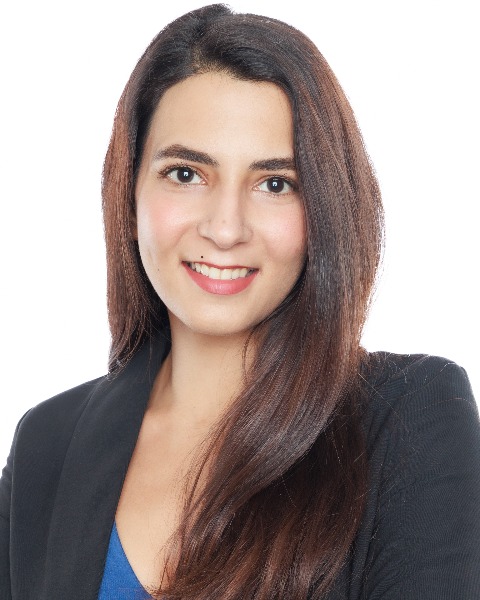Sunday Poster Session
Category: Interventional Endoscopy
P1087 - EUS-Guided Liver Biopsy in Pediatric Cholestasis: A Case Report of PSC/AIH Overlap Syndrome
Sunday, October 27, 2024
3:30 PM - 7:00 PM ET
Location: Exhibit Hall E

Has Audio

Aarushi Sudan, MD
NYC Health + Hospitals/Jacobi
New York, NY
Presenting Author(s)
Aarushi Sudan, MD1, Debra Pan, MD2, Sammy Ho, MD, FACG2
1NYC Health + Hospitals/Jacobi, New York, NY; 2Montefiore Medical Center, New York, NY
Introduction: Emerging literature highlights the feasibility and safety of endoscopic ultrasound (EUS) in children. EUS-guided liver biopsy (EUS-LB) is known to be safe, and effective for evaluating liver disease in adults, but its feasibility in children is unexplored. This case report describes an 18-year-old patient where EUS-LB effectively evaluated cholestatic symptoms, serving as a viable alternative to endoscopic retrograde cholangiopancreatography (ERCP).
Case Description/Methods: An 18-year-old male with ulcerative colitis (UC), malaria and G6PD deficiency presented with intermittent jaundice, and acholic stools for 6 months. Physical examination revealed icterus, with a soft, non-tender abdomen and no hepatosplenomegaly. Laboratory findings included Hb 9.7, AST 72, ALT 67, ALP 1180, D. Bilirubin 1.2, T. Bilirubin 2.1, GGT 1205. MRCP showed CBD dilatation, mild left intrahepatic biliary ductal dilatation with distal CBD narrowing and gallbladder sludge. Cholestasis was attributed to differentials including Primary Sclerosing Cholangitis (PSC), Autoimmune hepatitis (AIH), and biliary sludge from hemolysis. The patient was started on ursodiol, and an EUS-LB was planned. EGD was normal. EUS showed no pathology in the liver. EUS-LB revealed periductal concentric fibrosis and edema, portal lymphoplasmacytic inflammation with focal interface hepatitis, focal lobulitis, portal/periportal fibrosis, scattered bridging fibrous septa, and early nodularity, indicating PSC/AIH overlap syndrome. The patient was started on azathioprine and remained symptom-free with improved LFTs at follow-up visit.
Discussion: PSC is rare in the general pediatric population but occurs in upto 10% of children with UC. Approximately 80% of PSC patients have UC. Thus, PSC should be a differential in UC patients presenting with painless jaundice. Patients with IBD may also present with PSC-AIH overlap, typically unresponsive to conventional glucocorticoid therapy. Diagnosis of PSC involves a cholestatic LFT pattern and ERCP evidence of characteristic bile duct changes. However, ERCP carries significant complication risks. While it is unclear if ERCP-related adverse events are higher in children compared to adults, pediatric expertise in ERCP is limited. Histopathological analysis is crucial in suspected PSC-AIH overlap. EUS-LB, allowing sonographic and histological evaluation, can be pivotal in pediatric liver disease assessment, reducing the need for ERCP, and can be performed in an outpatient setting.
Disclosures:
Aarushi Sudan, MD1, Debra Pan, MD2, Sammy Ho, MD, FACG2. P1087 - EUS-Guided Liver Biopsy in Pediatric Cholestasis: A Case Report of PSC/AIH Overlap Syndrome, ACG 2024 Annual Scientific Meeting Abstracts. Philadelphia, PA: American College of Gastroenterology.
1NYC Health + Hospitals/Jacobi, New York, NY; 2Montefiore Medical Center, New York, NY
Introduction: Emerging literature highlights the feasibility and safety of endoscopic ultrasound (EUS) in children. EUS-guided liver biopsy (EUS-LB) is known to be safe, and effective for evaluating liver disease in adults, but its feasibility in children is unexplored. This case report describes an 18-year-old patient where EUS-LB effectively evaluated cholestatic symptoms, serving as a viable alternative to endoscopic retrograde cholangiopancreatography (ERCP).
Case Description/Methods: An 18-year-old male with ulcerative colitis (UC), malaria and G6PD deficiency presented with intermittent jaundice, and acholic stools for 6 months. Physical examination revealed icterus, with a soft, non-tender abdomen and no hepatosplenomegaly. Laboratory findings included Hb 9.7, AST 72, ALT 67, ALP 1180, D. Bilirubin 1.2, T. Bilirubin 2.1, GGT 1205. MRCP showed CBD dilatation, mild left intrahepatic biliary ductal dilatation with distal CBD narrowing and gallbladder sludge. Cholestasis was attributed to differentials including Primary Sclerosing Cholangitis (PSC), Autoimmune hepatitis (AIH), and biliary sludge from hemolysis. The patient was started on ursodiol, and an EUS-LB was planned. EGD was normal. EUS showed no pathology in the liver. EUS-LB revealed periductal concentric fibrosis and edema, portal lymphoplasmacytic inflammation with focal interface hepatitis, focal lobulitis, portal/periportal fibrosis, scattered bridging fibrous septa, and early nodularity, indicating PSC/AIH overlap syndrome. The patient was started on azathioprine and remained symptom-free with improved LFTs at follow-up visit.
Discussion: PSC is rare in the general pediatric population but occurs in upto 10% of children with UC. Approximately 80% of PSC patients have UC. Thus, PSC should be a differential in UC patients presenting with painless jaundice. Patients with IBD may also present with PSC-AIH overlap, typically unresponsive to conventional glucocorticoid therapy. Diagnosis of PSC involves a cholestatic LFT pattern and ERCP evidence of characteristic bile duct changes. However, ERCP carries significant complication risks. While it is unclear if ERCP-related adverse events are higher in children compared to adults, pediatric expertise in ERCP is limited. Histopathological analysis is crucial in suspected PSC-AIH overlap. EUS-LB, allowing sonographic and histological evaluation, can be pivotal in pediatric liver disease assessment, reducing the need for ERCP, and can be performed in an outpatient setting.
Disclosures:
Aarushi Sudan indicated no relevant financial relationships.
Debra Pan indicated no relevant financial relationships.
Sammy Ho indicated no relevant financial relationships.
Aarushi Sudan, MD1, Debra Pan, MD2, Sammy Ho, MD, FACG2. P1087 - EUS-Guided Liver Biopsy in Pediatric Cholestasis: A Case Report of PSC/AIH Overlap Syndrome, ACG 2024 Annual Scientific Meeting Abstracts. Philadelphia, PA: American College of Gastroenterology.
